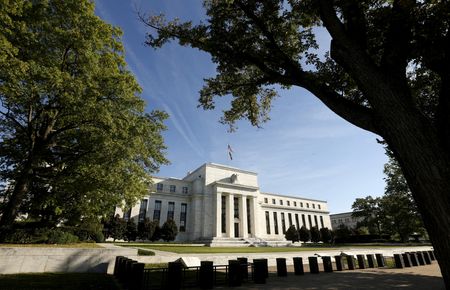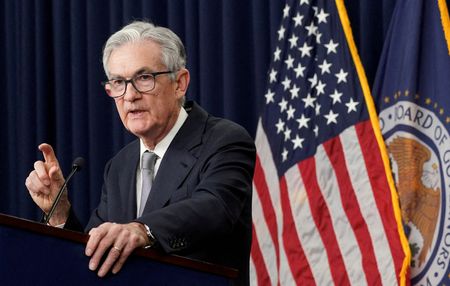By Ann Saphir and Michael S. Derby
(Reuters) -Federal Reserve policymakers signaled on Thursday that the U.S. central bank’s interest rate hikes are likely over, but left the door open to further monetary policy tightening should progress on inflation stall, and pushed back on market expectations for a quick pivot to rate cuts.
Fresh data shows price pressures are easing and the labor market is gradually cooling, evidence that the slowdown the Fed has tried to engineer with its rate hikes to date is underway.
Tighter financial and credit conditions after the Fed raised its policy rate 5.25 percentage points in the last 20 months should help bring inflation down further, New York Fed Bank President John Williams said on Thursday, noting that improvements in supply chains are also easing price pressures.
In balancing the risks of too-high inflation and a weaker economy, “and based on what I know now, my assessment is that we are at, or near, the peak level of the target range of the federal funds rate,” Williams said.
The personal consumption expenditures (PCE) price index rose 3% in October from a year ago, moderating from a three-month string of 3.4% readings though still above the Fed’s 2% target, and more Americans applied for unemployment benefits last week, government reports showed on Thursday.
Still, the unemployment rate at last read was 3.9%, only a few tenths of a percentage point above where it was when the Fed first began raising rates in March 2022. The government’s employment report for the current month will be released next Friday.
U.S. Treasury Secretary Janet Yellen said on Thursday she believes the U.S. economy does not need further drastic monetary policy tightening to prevent inflation from becoming ingrained and was on track to achieve a “soft landing” with strong employment.
UNCERTAIN PATH
Traders have been betting heavily that the Fed will keep its overnight benchmark interest rate steady in the 5.25%-5.50% range for the next several months. But they also expect rate cuts to start in May, with further reductions taking the policy into the 4.00%-4.25% range by the end of 2024 – a view that Williams made plain he does not share.
“I’m not losing too much sleep” over the market’s view “because there’s a lot of uncertainty about the future path of policy,” Williams said.
Models suggest the stance of Fed policy is the most restrictive it has been in 25 years, and it will probably need to stay restrictive for “quite some time,” Williams said.
Williams said he expects inflation to end this year at 3%, and ebb to 2.25% in 2024, as economic growth slows to 1.25% and the unemployment rate rises to 4.25%.
“If price pressures and imbalances persist more than I expect, additional policy firming may be needed,” Williams said.
San Francisco Fed President Mary Daly struck a similar tone in remarks to the German newspaper Borsen-Zeitung in an interview published on Thursday, noting her “base case” does not call for any further rate hikes, though it is “too early to know” if the Fed is finished with the rate increases.
“I’m not thinking about rate cuts at all right now,” Daly said. “I’m thinking about whether we have enough tightening in the system and are sufficiently restrictive to restore price stability.”
The policymakers spoke before a customary blackout period when they refrain from public comment ahead of a rate-setting meeting. The Fed will hold its next policy meeting on Dec. 12-13. Fed Chair Jerome Powell is expected to get a final word in on Friday, when he is due to speak at Spelman College in Atlanta.
Trader bets on Fed rate cuts starting in the first half of 2024 gained steam this week after Fed Governor Christopher Waller, an influential and usually hawkish policymaker, suggested rates cuts by then could be needed to keep policy from becoming overly restrictive in the face of easing inflation.
Daly and Williams were more cautious. Data has previously indicated progress that revisions or a change in momentum later erased, and both policymakers on Thursday emphasized the uncertainty of the current outlook.
“We still think the Fed will not want to be head-faked again, preferring to see further progress in key policy variables before declaring mission accomplished,” TD Securities strategist Oscar Munoz wrote.
(Reporting by Dan Burns, Michael S. Derby, Howard Schneider, David Lawder; Editing by Chizu Nomiyama, Paul Simao, Andrea Ricci and Will Dunham)


